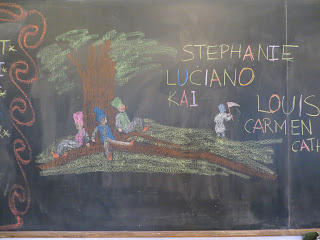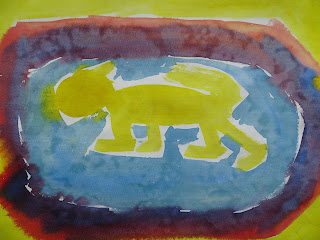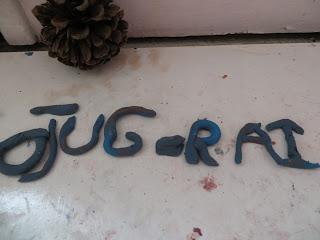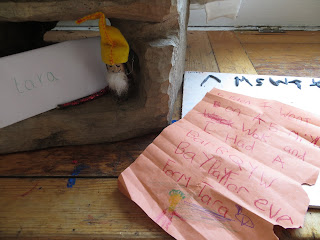 |
| Elementals |
Now all this may seem far fetched to adults, but there is a method in the vertical curriculum. Here is how it works: these are the beginnings of biology, zoology, physics and chemistry. It begins now, but not in a scientific way. It begins with poetry and observation because the whole point is to develop a sense of awe and wonder with the world around us - and therefore of affection and responsbility and love. We inhabit a living planet, and this environment around us nutures us. We need to love and care for it back. We observe and then we ask questions - how does a plant grow? Now this is an important part, especially for parents who love to tell children FACTS. This is what Waldorf education says about giving facts to children at too young an age: it is like giving a six year old a pair of shoes now and expecting them to wear it their whole lives. You do not give a child facts, you give it wonder. The facts they will discover later - because, as we all know facts change and if a child is given facts, this actually blinds them to reality and observation. And then - they may not be able to discover something new for themselves.
So when we do the elementals - it prepares the ground for science. But science in a living sustainable environment. And we do it with music, poetry, maths and just being out there and living it.
 |
| Vowel exercises |
 Here is the passage that has been filled in.
Here is the passage that has been filled in.
 |
| We also looked at the angel letters in our own names...that was lovely too |
 |
| This is what the board looked like after we had completed our Main Lesson that day |
 |
| Again this was a poem they learnt. We then copied it into the ML book |
This was to work on changing consonants to give different words. At this age the children are at different places with the letters. Which is understandable. I have now recognised that we all acannot have the same ML book any longer, not like we did in the first term. So for instance, some children will need help writing their poems. I take a yellow pencil and do a faint outline and go through the poem with them. Then they write it. Sometimes, they don't write it a all. We do it in plastercine instead. Yet other children are completely competent in doing their reading and writing and have even moved onto lower case letters themselves. That's ok too. The important thing is that everyone is trying their best. And eventually we'll all get there eventually.
 |
| Apologies for the weird formatting my camera does. Can't get it undone no matter how much i tried. |
Here are some samples of the ML work we do. The borders are form drawing. Everyday we do some form drawing - this is immeasureably healthy for the child. It helps with orientation, the mid-line, handwriting, it is therapeutic, it helps the child develop a feeling for patterns - and it is beautiful. If you ever doubt the importance of form drawing, you will see that FD is extremely useful for children who are still learning to tell the difference between right and left. It is also really REALLY good for the will. The children may dispute about the formation of letters, but they can see that a pattern in FD is not panning out. My approach is to watch a child do the FD. I watch the concentration and effort that goes into it. Do a little bit well, i tell them. It is more important than doing all four lines without any pattern.
One more thing about writing: as a teacher you go around reminding the children how to sit. You are kings and queens, you have a crown on your head and a cloak on your back. You are writing a decree to your subjects. You are sitting up straight so your crown does not fall or your cloak is not wrinkled. You are holding your pencil correctly. Your feet are on the floor. Your book is straight in front of you. Immediately you see the writing change. It is constantly reminding them at this stage to ingrain the habit into the body.
 |
| Watercolour from this week |
I am completely amazed at the control the children have over their colours now. It is a feat to get children to keep colours apart from each other and we do this slowly. To appreciate the quality of each other, the mood, its effect on other colours...this week we did yellow, then blue with red to make purple with yellow in the centre. Yellow is a notoriously difficult colour to keep clean and the kids did a great job. Where it did merge with the blue it made a lovely green. Here are some efforts. The golden lion is at the heart of the painting.
One of the criticisms of Waldorf education is that all pictures look the same. As we know they may start out the same, but they will never look the same in the end. This lion is in a dark cave. The one previously was in a lake. The one below is a lion in a jungle with its head down drinking some water... Much is often made of children's imaginations. Children must be encouraged to play, according to Waldorf education, and imagine - but there is very little originality. Because they are not ready yet to be original. This is an adult value placed on the world of childhood. At this stage in their lives, they are nourished as much as possible with beauty, awe, wonder and feeling - their Will is also strengthened. It is the Will with Feeling combined with warmed Thinking that will eventually give birth to originality - this will happen after 14 and hopefully, definitely after 21.
 |
| Plastercine words |
 |
| Some beautiful effort |
We are learning This is the Key to the Kingdom...while walking in a spiral.
 |
| The landing outside the class |
 |
| Sylph/Air |
 |
| Salamander/Fire |
 |
| Our gnomey postbox |
The kids learn that we write to communicate with each other. So the first things they have written have been letters. They put it into the gnomey postbox and then they collect it and read it. It is a great opportunity to teach politeness.
In addition to all of the above, we played the recorder, did very little knitting, did eurythmy, did baking, made whipper whoppers and a four faced rooster, and an Easter bunny decoration. It was a truly busy three weeks in Class One.















